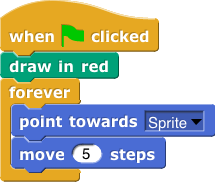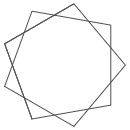-
Analyze and predict: How are the behaviors of these four scripts the same? How are they different?
Analyzing these scripts will help you control the speed of the drawings in the problems below.![Forever [ move (100), turn (90)] Forever [ move (100), turn (90)]](/June2017/bjc-r/img/1-introduction/forever(move100-turn90).png)
![Forever [repeat (10) [move (10)], turn (90)] Forever [repeat (10) [move (10)], turn (90)]](/June2017/bjc-r/img/1-introduction/forever(repeat10(move10)-turn90).png)
![Forever [repeat (20) [move (5)], turn (90)] Forever [repeat (20) [move (5)], turn (90)]](/June2017/bjc-r/img/1-introduction/forever(repeat20(move5)-turn90).png)
![Forever [repeat (100) [move (1)], turn(90)] Forever [repeat (100) [move (1)], turn(90)]](/June2017/bjc-r/img/1-introduction/forever(repeat100(move1)-turn90).png)
- "U1L2-SpriteOrbit"

- Give Sprite a script that, when the green flag is clicked, draws a blue square, drawing each line at some medium speed.
-
You write theCreate a second sprite with a script that does this:
 block.
block.

- Test your program. Make sure that it starts both sprites at the same time.
- Experiment with the speeds of each sprite.
- What happens if Sprite(2) moves 20 steps instead of 5 steps each time it goes through the forever-loop?
- What if Sprite(2) moves only 2 steps?
- What if Sprite draws its square more quickly?
 Describe the results of your experiments. Include pictures of the screen to show what happened. Try to explain why each picture came out as it did.
Describe the results of your experiments. Include pictures of the screen to show what happened. Try to explain why each picture came out as it did.
When you are finished, double-check that your script does exactly what you mean for it to. This is always a good idea when coding because if you move on with part of the program still not working, you will only compound your problems.


